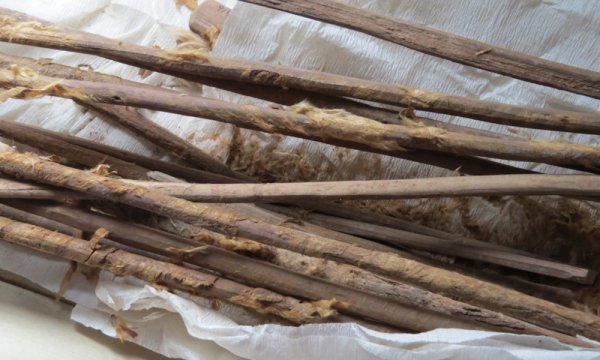(单词翻译:单击)
听力文本
This is Scientific American — 60-Second Science. I'm Cynthia Graber.
Got a minute?
For thousands of years, what's called the Silk Road was a group of land and sea trade routes that connected the Far East with South Asia, Africa, the Middle East and southern Europe. Of course, when humans travel they carry their pathogens with them. So scientists and historians have wondered if the Silk Road was a transmission route not just for goods, but for infectious disease.
Now we have the first hard evidence of ancient Silk Road travelers spreading their infections. The find comes from a 2,000-year-old latrine that had first been excavated in 1992. The report is in the Journal of Archaeological Science.
"So the site is a relay station on the Silk Road in northwest China. It's just to the eastern end of the Tarim Basin, which is a large arid area just to the east of the Taklamakan desert, and not far from the Gobi Desert. So this is a dry part of China."
Piers Mitchell, paleopathologist at the University of Cambridge, and one of the study's authors, along with his student Ivy Yeh and colleagues in China.
In the latrine, archaeologists found used hygiene sticks wrapped with cloth. These were used for what you think they were used for.

"This excavation was great because the cloth was still preserved and the feces was still adherent to the cloth on some of the sticks. So the archaeologist kept these sticks in the museum. And so my Ph.D. student, Ivy Yeh, who's first author on the paper, she went out to China took some scrapings from the feces adherent to the cloth. So we were then able to analyze that down the microscope when she brought it back to Cambridge."
Where they found eggs from parasites—including one from a liver fluke.
"And that's the exciting one because that's only found in eastern and southern China and in Korea, where they have marshy areas that have the right snails and the right fish."
The fluke needs snails and fish for its lifecycle, but there were no such snails or fish in this dry region of China. So the unlucky traveler who harbored the parasite had to have transported the disease to that spot.
"Well firstly it tells us that people were doing very long journeys along the Silk Road and you might think that's obvious. But no one really knew how long people were traveling. Some people may have been trading, only going short distances selling their goods on to the next person. And so the goods might have gone all the way along the Silk Road, but people might not. But we know that some people were doing huge distances..."
"Secondly it shows that this was, would be a viable route for the spread of those other infectious diseases like Bubonic plague and leprosy and anthrax that people had previously suggested might have been spread between East Asia and Europe along the Silk Road. Because modern genetic analyses have shown similarities between the strains of one end and the other."
Mitchell says there's much more work to be done to better understand the spread of diseases around the world. Perhaps from analyzing skeletons—or various other kinds of remains—to be found along the Silk Road.
Thanks for the minute for Scientific American — 60-Second Science Science. I'm Cynthia Graber.
参考译文
这里是科学美国人——60秒科学。我是辛西娅·格雷伯。
有一分钟时间吗?
数千年来,海洋与陆地之间的贸易路线丝绸之路将远东、南亚、非洲、中东和南欧连接起来。当然,人类在旅行时也携带着病原体。科学家和历史学家怀疑,丝绸之路运输的不仅仅是货物,还有传染性疾病。
现在,我们掌握了第一个有力的证据,证明古代丝绸之路的游客传播了自身的疾病。这项结果源自1992年发掘的一个有2000年历史的茅厕。该项研究结果发表在《考古科学:报告》杂志上。
“这里是中国西北部丝绸之路上的一个中转站。位于塔里木盆地的东端,塔里木盆地这块广阔干旱的地区位于塔克拉玛干沙漠的东部,距离戈壁沙漠不远。这里是中国的一个干旱地带。”
皮尔斯·米切尔是剑桥大学的古生物病理学家,同时也是该报告的作者之一,他和他的学生艾薇·叶以及来自中国的同事们一同进行了该项研究。
考古学家在发掘的茅厕里发现了用过的卫生棍,这些卫生棍用布裹着。这些东西的用途和你认为的一样。
“这次发掘意义很大,因为这些布仍然保存完整,而且排泄物还附着在一些棍子裹着的布上。考古学家把这些卫生棍保存在博物馆。我的博士学生艾薇·叶,同时也是该论文的第一作者,去中国刮取了布上的一些排泄物。这样,我们就能够在显微镜下分析她带回剑桥的样本。”
他们发现了寄生虫的卵,还有肝吸虫的卵。
“这项发现让我们兴奋不已,因为这些只存在于中国东部和南部以及韩国,那里的沼泽地有含有这些病原体的蜗牛和鱼类。”
肝吸虫需要依靠蜗牛和鱼类进行生命循环,但是中国干旱地区没有这些病原体所需要的蜗牛和鱼类。所以,携带着寄生虫的倒霉游客将疾病带到了该地区。
“首先,这告诉我们,人们沿着丝绸之路长途跋涉,你可能认为这是显而易见的。但是没有人确切知道人们到底走了多远。有些人可能一直在进行贸易活动,他们只走了很短的距离,将自己的货物转卖给他人。所以,货物可能要一直沿着丝绸之路运输,但是人就不一定了。不过我们知道有些人的确走了很远的距离。”
“其次,这项发现表明,这可能也是黑死病、麻风病和炭疽等传染疾病的传播路线,此前人们认为这些疾病沿着丝绸之路在东亚和欧洲之间传播。因为,现代基因分析表明,菌株一端和另一端存在相似性。”
米切尔表示,为了更好的了解疾病在世界范围内的传播,还有更多的工作要做。也许可以分析在丝绸之路上发现的骨骼或是其他类型的遗留物。
谢谢大家收听科学美国人——60秒科学。我是我是辛西娅·格雷伯。
译文为可可英语翻译,未经授权请勿转载!
重点讲解
重点讲解:
1. come from 来自;始于;
例句:The news comes from a reliable source.
这消息来自可靠的来源。
2. along with 与…一起;
例句:She came to dinner along with her boyfriend.
她和她的男朋友一道来用餐。
3. be adherent to 黏附;附着;
例句:The brass plate must be adherent to the steel.
黄铜片必须和钢粘结。
sell on 转卖;倒卖;
例句:Mr Farrier bought cars at auctions and sold them on.
法里尔先生拍得汽车后再将其转手。


